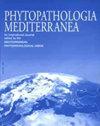与埃塞俄比亚南部苹果树溃疡病和枯死有关的红乌双孢霉首次报道
IF 1.9
3区 农林科学
Q2 AGRONOMY
引用次数: 1
摘要
1955年开始在埃塞俄比亚高地种植苹果树。2014年,在埃塞俄比亚哈迪亚地区的苹果园中观察到,主要在嫁接点以下的主茎上出现溃疡,导致树皮起泡,随后苹果树枯死,最终死亡。本研究旨在确定苹果树溃疡和枯死症状的病因。对20棵树(每个品种10棵)的症状树干进行取样。从10个树干(每个栽培品种5个)进行分离。从所有样品中获得具有相似培养特征的真菌菌落,并对具有代表性的分离物的形态进行了表征。对串联的内部转录间隔区1和2以及5.8S rRNA基因、大亚基和肌动蛋白基因区域的系统发育分析证实了两个分离株的身份为Didymosphaeria rubi ulmifolii。通过接种“Anna”和“Dorsett Golden”苹果树的健康枝条,形成病变,并随后重新分离接种的真菌,确认了一种分离物的致病性。这项研究是首次报道与苹果树枯死相关的杜比。这种病原体导致一个商业果园26%以上的苹果树死亡,并可能给埃塞俄比亚的小苹果种植者造成严重损失。未来的研究需要评估这种经济上重要的溃疡病在埃塞俄比亚的规模、分布和管理选择。本文章由计算机程序翻译,如有差异,请以英文原文为准。
First report of Didymosphaeria rubi-ulmifolii associated with canker and dieback of apple trees in southern Ethiopia
Cultivation of apple trees in the highlands of Ethiopia began in 1955. In 2014, blistering of the bark due to cankers on the main stems mostly below the grafting points, followed by dieback and eventually death of apple trees, was observed in apple orchards in the Hadiya Zone in Ethiopia. This study aimed to identify the causal agent of canker and dieback symptoms on the apple trees. Symptomatic trunks from 20 trees (ten per cultivar) were sampled. Isolations were performed from ten trunks (five per cultivar). Fungus colonies with similar cultural features were obtained from all the samples, and the morphology of a representative isolate was characterized. Phylogenetic analyses of the concatenated internal transcribed spacers 1 and 2 and 5.8S rRNA gene, large subunit and actin gene regions confirmed the identity of two isolates as Didymosphaeria rubi-ulmifolii. Pathogenicity was confirmed for one isolate by inoculations of healthy branches of ‘Anna’ and ‘Dorsett Golden’ apple trees resulting in lesion formation, and subsequent re-isolation of the inoculated fungus. This study is the first report of D. rubi-ulmifolii associated with dieback of apple trees. This pathogen caused death of more than 26% of apple trees in one commercial orchard, and could cause severe losses for smallholder apple growers in Ethiopia. Future studies are required to assess the magnitude, distribution and management options of this economically important canker disease in Ethiopia.
求助全文
通过发布文献求助,成功后即可免费获取论文全文。
去求助
来源期刊

Phytopathologia Mediterranea
生物-植物科学
CiteScore
4.40
自引率
8.30%
发文量
28
审稿时长
6-12 weeks
期刊介绍:
Phytopathologia Mediterranea is an international journal edited by the Mediterranean Phytopathological Union. The journal’s mission is the promotion of plant health for Mediterranean crops, climate and regions, safe food production, and the transfer of new knowledge on plant diseases and their sustainable management.
The journal deals with all areas of plant pathology, including etiology, epidemiology, disease control, biochemical and physiological aspects, and utilization of molecular technologies. All types of plant pathogens are covered, including fungi, oomycetes, nematodes, protozoa, bacteria, phytoplasmas, viruses, and viroids. The journal also gives a special attention to research on mycotoxins, biological and integrated management of plant diseases, and the use of natural substances in disease and weed control. The journal focuses on pathology of Mediterranean crops grown throughout the world.
The Editorial Board of Phytopathologia Mediterranea has recently been reorganised, under two Editors-in-Chief and with an increased number of editors.
 求助内容:
求助内容: 应助结果提醒方式:
应助结果提醒方式:


